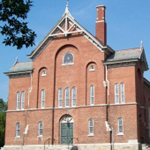 |
Lima Presbyterian Church |
 |
||||
|
The small village church at the main crossroads in Lima |
||||||
| Worship & Music | Faith Development | Congregational Life | Mission Outreach | Please Join Us | ||
| ||||||||||||||||||
|
Sermon – Easter 2011
"Do Not Be Afraid" In Matthew’s account of Jesus’ life, heaven and earth intersect only three times. Each intersection is a dramatic and pivotal moment when angels or the voice of the Lord speak to multiple people directly. The first time is at Jesus’ baptism where he is marked as the Son of God. There the Holy Spirit descends and a voice from heaven speaks saying, “This is my Son, the Beloved, with whom I am well pleased.” The second time is the transfiguration about 33 years later when Jesus, now a recognized rabbi, but already nearing the end of his ministry, appears to his disciples in radiant clothing on a mountain top. With him are two of the principal Old Testament figures, Moses and Elijah. A voice from the clouds speaks the same words as at his baptism, saying, “This is my Son, the Beloved, with him I am well pleased.” Then the heavenly voice adds, “Listen to him.” The disciples, representing us of course, are confused and afraid. Jesus reassures them, “Do not be afraid.” At that moment Moses and Elijah disappear, confirming to us that Jesus is their successor – that his voice alone is the one to listen to. Now, in this morning’s reading, we come to the third intersection, perhaps three months later. Jesus has been betrayed, crucified and placed in a burial cave with a big stone sealing off the entrance and armed guards in front. The two Mary’s have gone to the tomb to mourn or perhaps to finish preparing Jesus’ body for burial. The intersection that follows is different than the previous ones. Instead of the usual cloud, there is an earthquake, an event of direct terrestrial significance. We could play with this shift in metaphor a bit here. Previous intersections had featured a heavenly voice speaking of an earthly Jesus. Now we have, in effect, an earthly voice speaking of a heavenly Jesus. To continue the story, an angel appears, as radiant as Jesus transfigured, and sits triumphantly on the big stone, which has somehow been rolled away from the tomb entrance. The guards flee in terror fearing something really weird is going on. The women, however, remain, either brave or transfixed. The angel reassures them, “Do not be afraid.” This, of course, is an echo of Jesus’ admonition to his disciples on the mountain, “Do not be afraid.” Then the angel instructs the women to check out the open tomb. Despite the heavy stone and the guards, Jesus’ body has somehow been spirited away. The angel explains that Jesus has been raised from the dead. Look for yourselves, the angel says, the tomb is empty. Let me interject here a few words about the women in this account. Matthew identifies the women as Mary Magdalene and another Mary, either Jesus’ mother, or the mother of the disciple James. Mark’s gospel includes another woman, Salome. Luke’s includes a still different woman, Joanna. Whoever these women are, they are extraordinary. They are dutiful in coming to the tomb. They are brave, standing their ground following an earthquake and the appearance of a strange angel. Starring into the empty tomb they voice no doubts about Jesus’ resurrection. Unlike some of the disciples, they are willing believers. Matthew speaks of the women’s fear and joy as they ran to tell the rest of the disciples. He leaves out their willing obedience to the angel’s instruction to do so. Later, when Jesus appears they fall in front of him, touch his feet and worship him. Jesus’ life story as it comes to us is mostly populated with men, not too surprising given the patriarchcal culture of the time. What I am noting in this story are the exceptions to the norm, those extraordinary women who form bookends of a kind to the chronicle of Jesus’ life. There were the pregnant Elizabeth and Mary, at the beginning, and here there are the Mary’s and one or two others at the end. In bookends fashion, how fitting it would be if the awe and joy the women at the tomb were described as experiencing was similar to the awe and joy a pregnant woman might experience. In our Acts reading, Peter says these women were chosen by God to be witnesses. And if childbirth is an appropriate metaphor, their witness was of an extraordinarily involving, loving, and committed nature. In any event, if we need examples of goodness, if we need models of faithful responses to our Lord, we have them in these women. Now we come to another challenging part of today’s lesson. The angel explains that the tomb is empty because Jesus has been raised from the dead. In the very same sentence the angel goes on to say that Jesus has gone on ahead of the disciples into Galilee. Jesus is not returning to familiar Jerusalem, the center of political and religious authority. No, Jesus is going to back to the hinterlands of Galilee, distant, strange and unimportant. Galilee was a trade route and crossroads area populated by Greeks, Phoenicians, Syrians, and other non-Jewish people, worshippers of other gods, aligned with the Roman Empire, the hated occupiers and oppressors. Earlier the disciples had been relieved to get out of Galilee. Now the instructions were painfully clear, the disciples were twice instructed to meet Jesus there. “Go and tell my brothers to go to Galilee” Jesus says; “There they will see me.” Notice that Jesus uses the word ‘brothers’ to refer to the disciples. This indicates that he has forgiven them for deserting him over the previous days. As Jesus forgave the disciples, so he forgives us. Life must have been hard for those original disciples – constant travel, challenging teachings, threats from the powerful, no income, high expectations. And now here they were being told with authority to launch into yet another strange adventure in a place they knew to be unfriendly. They might have felt that they were trapped in endless sequels to Indiana Jones or Harry Potter movies. The lesson here is that the risen Jesus has not gone anywhere. He will return to the places of his earlier ministry and the disciples are still expected to accompany him. This forgiveness and this discipleship thing seem to have no end to them. For us it means that Jesus’ ministry continues in our midst, even here and even now and that we are expected to be part of it, just like the disciples of old. “Whoa,” you may be thinking, it’s one thing to see Indiana Jones in action on the screen, quite another to be Indiana Jones and to be expected to get out of the usual 12 tight spots in 90 minutes. “I’m just not cut out for that kind of thing,” you may be thinking to yourself. Besides, I have car payments. And yet we are twice told not to be afraid. That was us Jesus was speaking to wasn’t it? We know enough about how the world works that when someone tells us not to be afraid, we become suspicious. We’ve all heard dentists and tattoo artists and hair removal technicians say, “You’ll hardly feel this.” Imagine you’re on an airplane and the pilot comes on the intercom to announce that, “There is nothing to be concerned about folks, but we have shut down one engine, there is severe turbulence expected ahead, and we have decided to divert from Chicago to Milwaukee. Please remain in your seats with your seatbelts securely fastened and your tray table in its upright and locked position.” Nothing to worry about, right? When Jesus appeared to those remarkable women that Sunday, he greeted them and immediately repeated the angel’s words, “Do not be afraid.” This should not be understood as an assurance to them, or to us, that nothing was ever going to go wrong. Instead, like the airline pilot, Jesus was assuring them with his considerable authority, that when things did go wrong, he would be there with them, for he has gone on ahead. For us this is the assurance that Jesus will be there to meet us wherever we are on our journeys. Part of the joy of celebrating Easter is the realization that resurrection is not just a strange and awesome event recorded as happening some 2000 years ago. Instead it is something that is happening to us continually in the here and now. Christ makes us brave new creatures when we respond to him. Like the women at the tomb, with God’s help we can overcome sorrow and confusion, we can forge new relationships, we can let go of old hurts and prejudices, we can learn new ways of faithful living, even in strange times and places. We can if we believe our risen Lord is with us. We can if we trust in his assurance, “Be not afraid.” The tomb is empty. He is risen. Alleluia! Amen. |
| |||||||||